Marian Ionescu
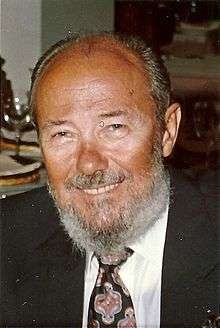
Marian Ion Ionescu (born 21 August 1929) is a pioneering British cardiac surgeon who spent his professional life initially in his native Romania and afterwards, the main part of his productive life, in Great Britain. His interest in heart surgery covered several aspects of this speciality.[1] He was an inventor of surgical devices, mostly artificial heart valves,[2] a scientist in the broad term and a medical educator.[3] In addition to his interests in literature and philosophy, his main passion was and remains high altitude mountain climbing.
Early life and medical career
Marian Ionescu's complex, adventurous and arduous life started in a small medieval town (Targoviste) in the shadow of the Carpathian Mountains where, during his high school years, he discovered the beauty of literature, the wonders of science and the magic and mystery of the mountains.
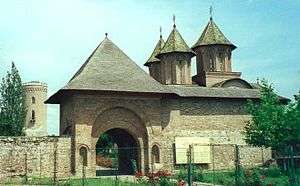
He attended medical school at the University of Bucharest and graduated in 1954. At this time he married Christina Marinescu, a medical school colleague who specialised in cardiology. Throughout their life she was a continuous support and played an important role in his later discoveries and inventions.
Following compulsory work as a general practitioner in rural areas, Ionescu obtained a World Health Organisation fellowship for cardiac surgery in the United States of America. During 1958 and 1959 he spent time at the Mayo Clinic with Dr D.C.McGoon, and at the Cleveland Clinic with Dr D.B.Effler in the clinical service, and with Dr W. Kolff in the Laboratory for Artificial Organs. Following this unique experience, he returned in 1964 to 'the source of real knowledge' as he used to call the United States. He spent more time at the Cleveland Clinic and at the Texas Heart Institute for further experience in heart surgery with Dr Denton A. Cooley.
Upon his return to Romania in 1960 he was appointed Consultant Cardiovascular Surgeon at Fundeni Hospital in Bucharest. In 1961 he became Chief of the Department of Cardiovascular Surgery and head of the Laboratory for Artificial Organs which he created and developed into a modern and efficient laboratory for research and experimental surgery. In a short time he built an intensive care unit and transformed the Department of Cardiovascular Surgery into a modern and very active cardiac surgical unit. The first open heart procedures with extracorporeal circulation were performed at the beginning of 1962.
During the years 1961 to 1965 Ionescu found himself to be progressively and severely constrained, not only by the lack of surgical material which could not be imported from abroard, but mainly by the increasingly complicated communist dictatorial Romanian political situation and by what his distant Roman ancestors would have called 'invidia medicorum pessima'.Finally frustrated by all these impediments and mainly by increasing political pressure, the Ionescus decided to make the bold and dangerous move to escape 'illegally' from Romania to the west. In the summer of 1965, in a little Fiat 600 car with nothing but two suitcases, a few books and some cans of reserve petrol, they took the risk to cross the frontiers to Yugoslavia and to Italy during moonless nights, and to reach Italy nationless and homeless but 'free'. This saga continued until they reached Paris where loyal and generous friends found them jobs for survival. Ionescu obtained a position in cardiothoracic surgery at Hôpital St. Joseph as 'locum intern', but in charge of most everything, especially at night and during the weekends. His wife got a similar position in cardiology at the Institute National du Sport.
Less than one year later Mr G.H.Wooler, a surgeon in Leeds, learned about their escape from Romania and, in search himself of a cardiac surgeon to bolster his fledgling unit at the Leeds General Infirmary, invited the Ionescus to come to England, and helped them to join his unit where they were able to work and develop their many original ideas. As it transpired, this was a seminal move, not only for the Ionescus but for the advancement of cardiac surgery in general.

The Ionescus would spend a quarter of a century in Leeds. That time was the most prolific and productive period for the Ionescus and for Leeds. In 1968 Ionescu, following a complex examination, became Licentiate of the Apothecaries Hall of Dublin. In 1971 he was appointed Consultant Cardiothoracic Surgeon at the General Infirmary at Leeds, at Killingbeck Hospital Leeds and Reader in Surgery at Leeds University. Upon Mr Wooler's retirement in 1974, Ionescu became the Chief of the Department of Cardiothoracic Surgery. He was later appointed as Consultant to the Ministry of Health (United Kingdom) for matters related to artificial heart valves. The cardiac surgical unit in Leeds became one of the most productive centres in Great Britain which attracted a considerable number of overseas surgeons for further training or for scientific visits.
During his entire life as an active cardiac surgeon, Ionescu made significant and original contributions to cardiovascular science in several fields. He has been a prolific writer, a medical educator and a tireless speaker.His opinions, which were based on his vast knowledge of literature and philosophy, often generated interesting discussions and occasionally heated but healthy debate. He is a highly respected senior figure in international cardiac surgical circles. In 1987 he retired from active surgical work[4] and despite some health problems he pursues his lifelong passion for high altitude mountain climbing.
Medical pioneer
Marian Ionescu's entire medical career was dominated by scientific curiosity and a persistent desire and ability to make progress by creating change, by discovering the unknown, by improving the known and by inventing what he thought would be useful.[5]
In 1959 in Cleveland, at Dr Kolff's impulse, he created the first 'single leaflet aortic valve' out of polyurethane. This device never went beyond the experimental stage due to clot formation. During 1961 and 1962 in Romania, he conducted, with his team, extensive experimental and clinical work on the physiology of organisms under deep hypothermia, with the aid of extracorporeal circulation, in animals and in man. The body temperature was lowered to between 6 and 15 oC and complete circulatory arrest of up to 56 minutes was maintained without significant negative effects.[6]
At Leeds Ionescu designed, created and implanted in the mitral position in humans, for the first time ever, porcine aortic valves attached to a Teflon cloth collar, starting in February 1967.[7] This was followed by the creation of the Dacron covered titanium frame[8] for mounting the porcine aortic valves to be able to implant them in all three cardiac locations (mitral, aortic, tricuspid). With various modifications and improvements, these stent mounted valves had been implanted in 87 patients between February 1967 and March 1969. All these valves were treated with formaldehyde and this was the main reason for their limited durability.[9]
In a continuous search to create a tissue heart valve which could be used without anticoagulant treatment, Ionescu created a novel artificial valve. Using autologous fascia lata tissue (the fibrous membrane which covers the outside aspect of the thigh muscles) taken from the patient and used to construct the valve during the operation by mounting the living fascia on a Dacron-covered titanium frame in the shape of a three cusp valve.[10] He began the clinical implantation of these valves in April 1969. This procedure of valve construction and implantation had been used in many centres in the world for about three years until it was realised that fascia lata did not perform well over longer periods of time in the high pressure environment of the left heart.These valves became incompetent after various durations post implantation – from 3 to 12 years. However, two important facts were established by the use of such valves. The haemodynamic performance in both mitral and aortic positions was superior to all known artificial heart valves and that the risk of thrombosis and embolisation was minimal when compared with mechanical valves.[11] Freehand insertion of stentless fascia lata aortic valves was also used in a small number of cases with similar results.[12]
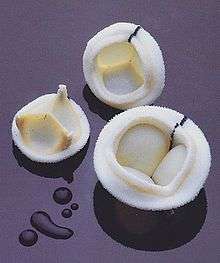
In his continuous search for the 'Holy Grail', Ionescu experimented with valves made from bovine pericardium (the membrane which surrounds the heart) treated with glutaraldehyde and mounted on a Dacron covered titanium frame.[13] This original valve, designed and created by Ionescu, demonstrated excellent hydrodynamic performance with good durability during in-vitro fatigue testing. In March 1971 Ionescu began the clinical implantation, for the first time, of this original device. The results were very encouraging. In 1976 Shiley Laboratory in California began to manufacture and to distribute worldwide this valve under the name of 'Ionescu–Shiley Pericardial Xenograft'. Its use by Ionescu and many other surgeons demonstrated very good performance in all aspects until 6 to 10 years post-operatively when signs of malfunction appeared progressively in younger patients and some of the valves had to be removed and replaced. Although a small percentage of the pericardial valves continued to function normally for up to 26 years post-implantation, the majority of them had to be replaced between 6 and 14 years, and a few some time later.[14][15]
In the mid-eighties Shiley Company was acquired by the drug laboratory Pfizer. At around that time a series of severe problems were encountered with the mechanical Bjork–Shiley valve.[16] As a consequence of these problems, Shiley Company stopped the manufacture of all of its products, including the Ionescu–Shiley Pericardial Xenograft, and the company was wound up. Although the clinical results with this pericardial valve were better than all other stented tissue valves at that time, the longer term durability remained still to be attained.
Some 10 years after the creation of the pericardial valve by Ionescu, and its use by numerous surgeons[17] and after having demonstrated its excellent haemodynamic performance and the reduced propensity for thrombo-embolism, other companies began manufacturing and distributing a plethora of rather similar pericardial valves.[18] None of these showed a better performance than the original Ionescu valve with the exception of a pericardial valve modified and built by Edwards Laboratories and commercialised under the name of 'Carpentier-Edwards Pericardial Bioprosthesis.'[19] This valve is reported to perform better than its predecessor, the original Ionescu–Shiley valve.However, a correct comparison between these two valves cannot be made because the Ionescu valve had been used by most surgeons in patients of all age groups and mostly younger than 65 years, as was the custom in the Seventies and Eighties. The Edwards valve, on the other hand, is being used since the mid-eighties almost exclusively in patients above the age of 65–70 years in whom the risk of primary valve failure is now known to be significantly lower.[20]
Ionescu also created the concept of performing multiple sequential haemodynamic investigations of patients following heart valve surgery, to evaluate, in time, the patient's condition.[21][22]
In the field of congenital heart disease, Ionescu was the first surgeon to successfully reconstruct a heart with a single ventricle[23] and continued to use various techniques for the repair of such a complex abnormality.
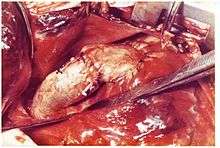
For the repair of congenital cyanotic cardiac diseases he created and built, initially in his hospital laboratory, two original devices: the 'mono-cusp patch' for the correct enlargement of the narrowed pulmonary artery and annulus and a valved conduit (a tube containing a three-cusped valve) for cases with discontinuity between the right ventricle and the pulmonary artery. These devices were made of fascia lata[24] and later, using glutaraldehyde treated bovine pericardium.[25]
Marian Ionescu's achievements were the fruit of an inquisitive mind and a fertile imagination doubled by the courage to dare to try and the determination to persist until the completion of the project. He had the true grit, the stamina to 'burn the midnight oil' most of the time at work, and much more than many. He often drove himself to extremes whether in medical matters or on the high mountains. The notoriety generated by his surgical achievements was handled with modesty and generosity, always giving credit to his associates. Although he was very demanding of his junior staff, he stimulated their interest for academic achievement.
One could summarise Marian Ionescu's major scientific contribution in a few sentences. His main lifelong objective was to create a durable artificial heart valve which could be used without anticoagulant treatment. If he did not fully realise his goal, he came very close to it. He conceived, designed and introduced into clinical use the pericardial heart valve.This novel concept became the basis for subsequent modifications made by others, leading to the creation of a potentially 'perfect' tissue heart valve.
Interests
In addition to his lifelong interest in literature and philosophy, Marian Ionescu's passion remains for high altitude mountain climbing. He succeeded even at an advancing age to scale many mountains and peaks in the Alps and the Himalayas, most of them of high technical difficulty.
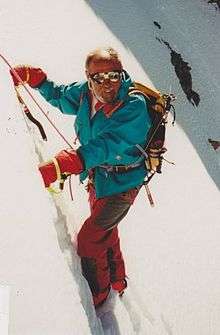
Quotes
"Progress is a continually ascending spiral, a stepwise extension of the horizon and of the quality of knowledge."[26]
"The creation of the stented pericardial valve opened a door towards further potential improvements, as this valve, being entirely man-made, lends itself to a multitude of permutations of shape in order to further improve its long term performance."[27]
"Sometimes I feel the impulse to scream: what the hell, let's try again, let's give it a roll, let's go for the hidden side of the moon."[28]
Endowments
The Ionescus created and endowed 'The Marian and Christina Ionescu Fellowships' for training and scientific advancement in cardiac surgery. These are linked with:
- The University of Leeds
- The British Heart Foundation
- The Society for Cardiothoracic Surgery in Great Britain and Ireland
- Contributed significantly to build the PDSA PetAid Hospital "The Marian and Christina Ionescu Centre" in Cardiff in 2013
- Contributed significantly to build the Birmingham (Oldbury) Pet Hospital "The Marian and Christina Ionescu Centre Of Surgical Excellence 2015
Medals, awards, and honorary titles
- Bisturi d'Oro (Italy),1969
- Merit Awards for Distinguished Achievements in Cardiac Surgery from the Department of Health and Social Security, London: C, B and A Awards from 1975 to 1987
- The John H Gibbon Award and Medal for Outstanding Contribution to Perfusion Technology (USA),1982
- "Who's Who in the World" The Marquis Publication Board (USA), 1982–1985
- Certificate of Merit for Distinguished Achievement (Men of Achievement USA), 1984
- Honorary Member of the Romanian Academy of Medical Sciences, 1995
- Honorary Professor of the Faculty of Medicine 'Carol Davila', University of Medicine and Pharmacy, Bucharest, 1995
- Honorary Citizen of the town of Giurgiu, Romania, 1997
- Zermatt dankt (Switzerland), 1999
- "The Marian Ionescu Skills Laboratory", for training young heart surgeons at the Leeds General Infirmary, 2004
- Honoured by the Society for Cardiothoracic Surgery in Great Britain and Ireland by naming its University: The SCTS-IONESCU UNIVERSITY in 2114
- The SCTS Lifetime Achievement Award for Cardiac Surgery 2015
Fellowships
- Licentiate of the Apothecaries Hall of Dublin (L.A.H.), (Medicine, Surgery, Midwifery and Pharmacy) 1968
- Fellow of the American College of Surgeons (F.A.C.S.), 1972
- Fellow of the International College of Angiology, Scientific Council, 1980
- Fellow of the Royal College of Surgeons, England (F.R.C.S.), 1984
- Fellow of the American College of Chest Physicians (F.A.C.C.P.), 1984
- Fellow of the International Academy of Chest Physicians and Surgeons, 1984
Membership of scientific societies
Societe Internationale de Chirugie (1963). International Society for Cardiothoracic Surgery (1963). Society for Cardiothoracic Surgery in Great Britain and Ireland (1967). Yorkshire Thoracic Society (1968). The Leeds and West Riding Medico-Chirurgical Society (1969). British Cardiac Society (1970). International Editorial Board of the European Journal of Cardiology (1973). International Study Group for Research in Cardiac Metabolism (1974). European Society for Cardiovascular Surgery (1977). Pan-Pacific Surgical Association (1978). Honorary Member of the Denton A. Cooley Cardiovascular Surgical Association (1978). International Society for Artificial Organs (1979). The Society of Thoracic Surgeons (USA) (1980). The American Heart Association, Member of the Council for Cardiovascular Surgery (1981). European Society of Cardiology (1983). La Sociedad de Cardiocirujanos (Spain, 1983). The New York Academy of Sciences (1983). Honorary Member of The Association of Thoracic and Cardiovascular Surgeons of Asia (1983). Founding Member of the International Association for Cardiac Biological Implants (1984). Honorary Member of the European Association for the Study of Bioprosthesis (1985). The Editorial Board of the Journal of Cardiac Surgery (1985). Honorary Member of Societatea Romana de Cardiologie (1995). Honorary Member of the Romaniae Scientiarum Societas (1995)
Publications
- 242 Original scientific articles on various aspects of cardiovascular and thoracic surgery have been published in several medical journals.
- 37 Chapters were published in books and treatises
- 10' Books written/edited as follows:
Collective Work (1962) Circulatia Extracorporeala si Hipotermia Profunda. Ed Academia R.P.R, Bucharest, Romania.
Marinescu V., Pausescu E., Ionescu M.I. Catecolaminele, Biologie si Patologue. Ed Academia R.P.R, (1965) Bucharest, Romania.
Ionescu M.I., Ross D.N., Wooler G.H. Biological Tissue in Heart Valve Replacement. Butterworths, (1972) London. y Ionescu M.I., Ross D.N., Wooler G.H. I Trapianti Valvorali Cardiaci con Tessuti Biologici.. Edizioni E.M.S.A., (1972), Napoli.
Ionescu M.I., Wooler G.H. Current Techniques in Extracorporeal Circulation. Butterworths, (!976), London.
Ionescu M.I. Tissue Heart Valves. Butterworths,(1979), London.
Ionescu M.I. Techniques in Extracorporeal Circulation. Butterworths,(1981), London.
Ionescu M.I., Cohn L.H. Mitral Valve Disease, Diagnosis and Treatment. Butterworths, (1985), London.
The Pericardial Heart Valve - The Odyssey of a Continuously Evolving Concept SCTS, (2015) London
Perspectives in Cardiothoracic Surgery - The SCTS Ionescu University, Volume I SCTS, (2016), London
Oral presentations
- 186 Papers were presented at different scientific meetings
- 122 Lectures were given by invitation at various universities and medical centres
- 22 Visits for 'round table' or surgical operative demonstrations
Key Words Open heart surgery. Extracorporeal circulation. Deep hypothermia. Complete circulatory arrest. Porcine aortic valve. Autologous fascia lata valve. Bovine pericardium. Titanium frame. Formaldehyde. Gluteraldehyde. Heterograft. Ionescu–Shiley pericardial xenograft. Sequential haemodynamic investigations. Single ventricle. Mountain climbing.
http://marianionionescublog.blogspot.com
References
- ↑ Shumacker H B Jr. The Evolution of Cardiac Surgery.Indiana University Press (1992), Bloomington, Indianapolis. pages 199,269,310,313–315 ISBN 0-253-35221-5
- ↑ Westaby S, Bosher C,Landmarks in Cardiac Surgery.ISIS Medical Media, (1997) Oxford,pages 157–159,168, ISBN 1-899066-54-3,
- ↑ 125th Anniversary Exhibition at The General Infirmary at Leeds since the opening of the Gilbert Scott Building 1868–1993 | Woodgate Graphic Design Consultants, Leeds.
- ↑ Gonzalez-Lavin L. (1988) "Letter to the editor, on the retirement of Marian I. Ionescu from clinical practice." Journal of Cardiac Surgery,3,1,85–86 |,
- ↑ Robicsek F "The Application of Biological Tissue in Cardiac Valve Surgery. The History of the First Two Decades, Journal of Heart Valve Disease, 3,6,613–626 |
- ↑ Collective Work, Circulatia Extracorporeala si Hipotermia Profunda Editura Academiei, (1962), Bucharest
- ↑ Ionescu M I, Wooler G H, Smith D R, Grimshaw V A (1967), "Mitral Valve Replacement with Aortic Heterografts in Humans" Thorax,22, 4, 305–313 |.
- ↑ Westaby S, Bosher C,Landmarks in Cardiac Surgery,ISIS Medical Media, (1997), Oxford, pages 157–159,168
- ↑ Ionescu M I, Smith D R, Petrila P A, Wooler G H, "Heart Valve Replacement with Supported Aortic Heterografts". In: Ionescu M I, Ross D N, Wooler G H, Eds. Biological Tissue in Heart Valve Replacement, Butterworths, (1972), London, pages 467–513.
- ↑ Ionescu M I, Ross D N, "Heart Valve Replacement with Autologous Fascia Lata", The Lancet,294, 7616, pages 335–338
- ↑ Ionescu M I, Deac R C,Whitaker W, Wooler G H, "Fascia Lata Heart Valves", In: Ionescu M I,Ross D N, Wooler G H, Eds. Biological Tissue in Heart Valve Replacement Butterworths,(1972), London, pages 617–865.
- ↑ Ionescu M I, Holden M D, Petrila P A "Fascia Lata Heart Valves; with section on Free Fascia Lata Grafts for Aortic Valve Replacement" In: Ionescu M I, Ross D N, Wooler G H, Eds. Biological Tissue in Heart Valve Replacent, Butterworths, (1972), London, pages 673–685.
- ↑ Ionescu M I, Tandon A P, Mary D A S, Abid A, (1977), "Heart Valve Replacement with the Ionescu–Shiley Pericardial Xenograft", The Journal of Thoracic and Cardiovascular Surgery,73, 1, 31–42 |.
- ↑ Ionescu M I, Tandon A P, Silverton N P, Chidambaram M, Smith D R,"Long term Durability of the Pericardial Valve", Proceedings of the Cardiac Prosthesis Symposium III, Montreux,Switzerland, 1985, Shiley Incorporated, (1987), Irvine, California, pages 111–119
- ↑ Bodnar E, Yacoub M,Eds,"Biologic and Bioprosthetic Valves,"Proceedings of the Third International Symposium,Yorke Medical Books, (1986), New York, pages 163–225
- ↑ Blackstone E H (2005) "Could it Happen Again? The Bjork–Shiley Convexo-Concave Heart Valve Story", Circulation, 111, 2717–2719 |
- ↑ Bodnar E, Yacoub M, Eds. "Biologic and Bioprosthetic Valves" Proceedings of the Third International Symposium, Yorke Medical Books, (1986), New York,pages 163–225,
- ↑ Bodnar E, Yacoub M,Eds. "Biologic and Bioprosthetic Valves"Precedings of the Third International Symposium, Yorke Medical Books, (1986), New York, pages 643–759.
- ↑ Cosgrove A M, Lytle B W, Taylor P C, Camacho M T, Stewart R W, et al (1995) "The Carpentier–Edwards pericardial aortic valve; ten-year results",Journal of Thoracic and Cardiovascular Surgery,110, 3, 651–662.
- ↑ Thamilarasan N, Griffin B, (2002), "Choosing The Most Appropriate Heart Operation and Prosthesis", Cleveland Clinic Journal of Medicine, 69,9,688–703 |.
- ↑ Ionescu M I, Tandon A P,"The Ionescu–Shiley Pericardial Xenograft Heart Valve", In: Ionescu M I Ed.Tissue Heart Valves, Butterworths, (1979), London, pages 201–252
- ↑ Tandon A P, Smith D R, Mary D A S, Ionescu M I,(1977), "Sequetial Haemodynamic Studies in Patients having Aortic Vallve Replacement with the Ionescu–Shiley Pericardial Xenograft", Annals of Thoracic Surgery,24,149–155 |
- ↑ Ionescu M I, Macartney F J, Wooler G H (1973) "Intracardiac Repair of Single Ventricle With Pulmonary Stenosis"The Journal of Thoracic and Cardiovascular Surgery,65,602–607 |
- ↑ Ionescu M I, Deac R C,(1970),"Fascia Lata Composite Graft for Right Ventricular Outflow Tract and Pulmonary Artery Reconstruction",Thorax,25,4,427–435 |
- ↑ Ionescu M I,Macartney F J, Wooler G H, (1973),"Intracardiac Repair of Single Ventricle with Pulmonary Stenosis", The Journal of Thoracic and Cardiovascular Surgery,65,602–607
- ↑ Gonzalez-Lavin L, (1988), "Letter to the Editor, on the retirement of Marian Ionescu from clinical practice", Journal of Cardiac Surgery, 31, 1, 85–86
- ↑ Ionescu M I, Tandon A P, Silverton N P, et al,"Long Term Durability of the Pericardial Valve", Proceedings of the Cardiac Prosthesis Symposium III, Montreux, Switzerland, 1985, Shiley Incorporated, (1987), Irvine, California
- ↑ Ionescu M I, (2006),"About Utopia and The Ephemeral," Lecture at the Annual Scientific meeting of the Society for Cardiothoracic Surgery in Great Britain and Ireland, Dublin, 13–16 March 2006